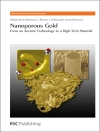Arne Wittstock is at the Universitõt Bremen/Institute for Applied and Physical Chemistry and Lawrence Livermore National Laboratory, Physical and Life Science Directorate, Nanoscale Synthesis and Characterization Laboratory, USA. He studied chemistry at the University of Bremen and completed his diploma thesis at Kr³ss Gmb H in Hamburg. Afterwards, he undertook his doctoral studies in Marcus Bõumer”s group at the Institute for Applied and Physical Chemistry and received his Ph D from the Department of Chemistry at Bremen University. Meanwhile he was also a visiting researcher at the Nanoscale Synthesis and Characterization Laboratory at the Lawrence Livermore National Laboratory. Since 2010, Arne Wittstock has co-supervised the projects on nanoporous gold at the Institute of Applied and Physical Chemistry and he also joined the Lawrence Livermore National Laboratory working on nanoscaled functional materials. His main research interests lie in the field of the physical chemistry of surfaces, nanostructured materials for energy-related applications, sensors, and catalysis. He has published several papers in Science, Nature Materials, Nano Letters and other key journals and also possesses patents. Juergen Biener is currently one of the leaders in the Nanoscale Synthesis and Characterization Laboratory at the Lawrence Livermore National Laboratory, USA and a Harvard affiliate. He studied chemistry at the Ludwig-Maximilians-Universitõt in Munich and completed his doctoral research in the field of surface science at the Max-Planck-Institute of Plasma Physics (IPP) in Garching. He received a fellowship from the German Academic Exchange Service (DAAD) to work with Bob Madix at Stanford University on metal oxide model catalysts. He then returned to the IPP to continue his research on plasma-wall interactions and in 2003 he accepted a visiting scientist position at the Center for Imaging and Mesoscale Structures at Harvard University where he started his work in the field of gold surface chemistry. Currently, his research interest lies at the intersection of surface chemistry, physics and mechanics of high-surface-area materials. He is the author of over 100 scientific publications, patent applications and book chapters. Jonah Erlebacher is at the Department of Materials Science and Engineering, Johns Hopkins University, USA. Marcus Bõumer is a Professor at the Institute of Applied and Physical Chemistry at the University of Bremen where he leads a research group working on nanostructured surfaces and innovative catalytic materials. He graduated in chemistry and received his Ph D at the Ruhr-University Bochum, Germany in 1994. In the following years, he carried out postdoctoral research at the Ruhr-University, Stanford University, USA and the Fritz-Haber-Institute, Berlin, Germany. In 2000, he received his habilitation in physical chemistry at the Technical University Berlin and became Professor at the University Bremen in 2002. His current research areas comprise nanoporous materials, colloidal nanoparticles and rare earth oxide materials and their use in heterogeneous catalysis and sensorics.
4 Ebooks by Po-Yu Chen
Arne Wittstock & Jürgen Biener: Nanoporous Gold
High-surface-area materials have recently attracted significant interest due to potential applications in various fields such as electrochemistry and catalysis, gas-phase catalysis, optics, sensors a …
PDF
English
DRM
€179.99
Stevo Najman & Vojislav Mitić: Bioceramics, Biomimetic and Other Compatible Materials Features for Medical Applications
This book reports on advanced biomaterials such as bioceramics, hydrogels, biopolymers, nanomaterials, membranes, and other compatible materials for medical applications. It introduces materials as b …
PDF
English
€171.19




